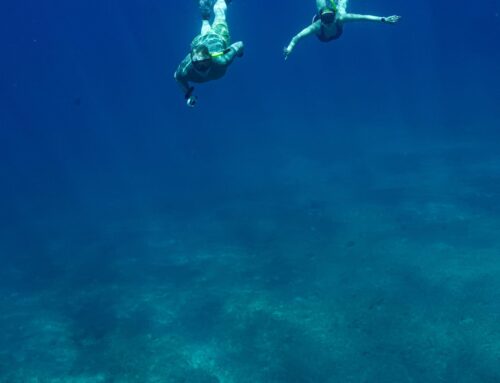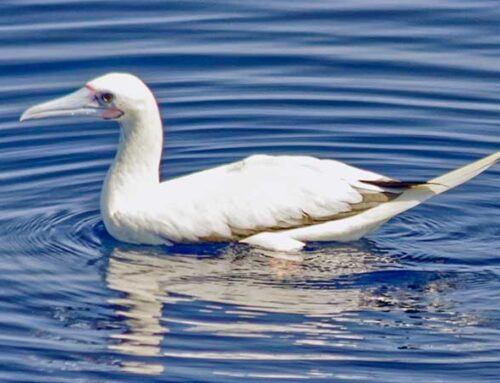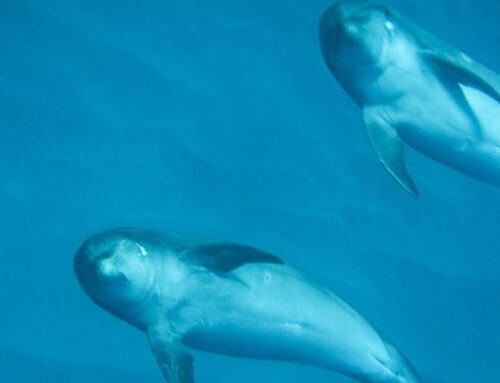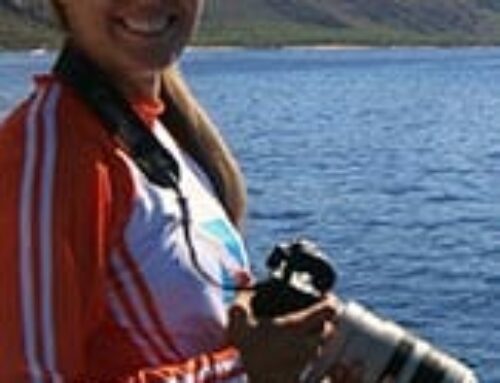High Street Cleaners
The story of the cleaner wrasse provides an insight into complex interspecific behaviors’ and an early warning of the state of our coral reefs.
Mr Labroides phthirophagus (the Hawaiian cleaner wrasse) lives on the corner of Reef Crest. He runs a little business, the fish equivalent of a dentist or hairdresser’s. He (or she) is a professional skin doctor and makes a decent living removing parasites, displaced scales and necrotic tissue from eager client fish.
Evolution has ensured that Mr Labroides has a strong and recognizable brand. Fish all over the world recognize the black stripe outlined in vivid blue that runs the length of his body in the same way that a young child instantly recognizes the McDonald’s logo.
Mr Labroides is an astute businessman and considers all the aspects necessary to run a successful operation. He chooses the location for his cleaner station with care, ideally somewhere prominent on the reef such as over an obvious plate coral or tabulate Acropora. He spends some time performing an eye-catching zig-zag dance around the area to advertise the fact that he is in business and drawing potential clients into his surgery.
A cleaning service for clients
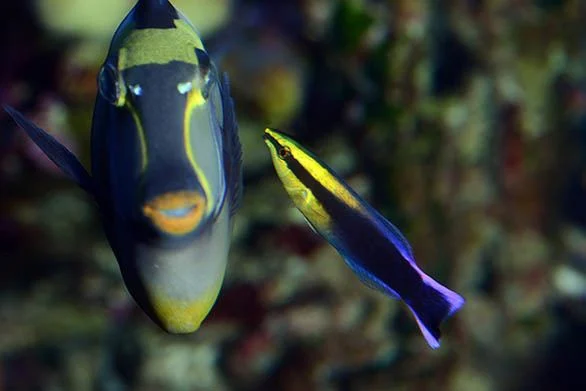
The Hawaiian Cleaner Wrasse (right), Labroides phthirophagus.
Clients visit him either because they have been there before and appreciate the good service he delivers or because they happen to be passing and recognize his advertisement.
He treats his clients as individuals; he spends most time with those that he values because they are large or have lots of parasites, and he occasionally offers an economy or lower level of service to those that are less profitable.
His favorite clients are parrotfish covered in mucus and debris from their night spent holed up in their mucus sleeping bag; large and old groupers; goatfish that have spent the day grubbing around in sediments; and jelly-fish covered fusiliers.
He is less inclined to spend time dealing with smaller species such as dascyllus, damsels or other wrasse.
He’s a busy little chap; some folk have estimated that he may take 1,200 parasites from clients a day and that some clients may spend up to a third of their day in his salon. He is in such demand that clients will often queue for lengthy periods awaiting his attention.
When he begins his ministrations with a visual and tactile inspection, peering closely and brushing his pectoral fins over the surface of the client, they will stop moving and open their mouths and operculae in order to facilitate his activity.
Trust and competition
There is a mutual trust between Mr Labroides and his clients: they trust him not to nibble at delicate gill tissues; he trusts them not to eat him while he cleans their teeth. The trusting atmosphere extends beyond the relationship between cleaner and client – those that are queuing up waiting their turn appear abnormally quiescent, and you will rarely see one potential client fighting with or eating another. About 80% of photographs of fish that you see in coral reef guides will have been taken at cleaner stations, where the calm and unafraid behavior of the clients gives the photographer ample time to approach their subject.
Cleaner wrasse can, to some degree, be regarded as the miner’s canary of coral reefs
Mr Labroides is not an altruist though and seeks to make profit wherever he can. Occasionally, if he thinks he can get away with it he may take an extra little nibble of tissue or scale, perhaps hoping that his misdemeanor may be considered accidental by his client. He has to be careful though as other clients eavesdrop on his activities and a step too far may lose him a valuable client and even damage his reputation. A client that feels he has been cheated is likely either to seek the services of another branded cleaner fish or to retaliate.
Mr Labroides has to deal with the fact that there are often several other similar operations to his own, sometimes run by his many girlfriends, that will compete for client fish. He tolerates the operations of juvenile cleaner fish around his cleaning station, allowing them to pick up trade that he can afford to ignore as it is less profitable. Juvenile cleaners concentrate their efforts on smaller clients, probably benefiting from the advertising activities of the adult fish.
These highly complex interactions exist on healthy reefs and it is likely that, because of their dependence on a broad range of species, they are of the utmost fragility. Cleaner wrasse can, to some degree, be regarded as the miner’s canary of coral reefs.
For further information see:
Côté IM (2000) Evolution and ecology of cleaning symbioses in the sea. Oceanography and Marine Biology Annual Review 38: 311-355
Stummer LE, Weller JA, Johnson ML, Cote IM (2004) Size and stripes: how fish clients recognize cleaners. Animal Behaviour 68: 145-150
Cleaner Wrasse at the Green Sea Turtle Cleaning Station

